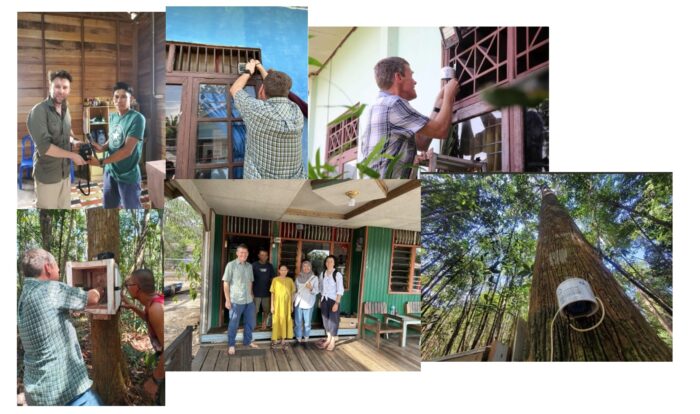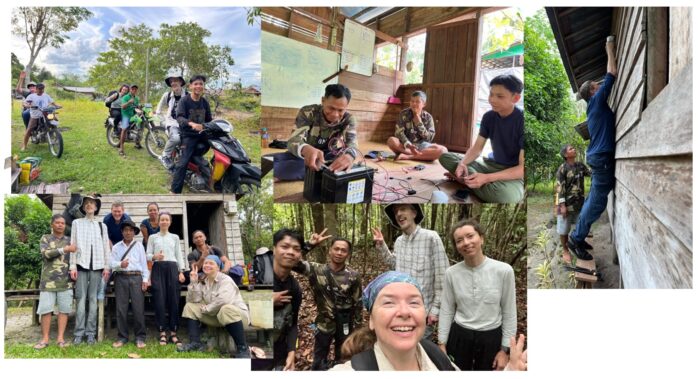Better understanding the air pollution in Central Kalimantan
Fieldwork Reflections from the Kalimantan Lestari Project by Ailish Graham.
March 2025 will mark the end of the Kalimantan Lestari (KaLi) project, in which I have been lucky enough to be involved since March 2023. The aim of our work in Leeds and LSE was to better understand the impact of peat fire smoke in Central Kalimantan, Indonesia on the local population.
To give some context to this issue, in the 1990s the ‘Mega Rice Project’ (MRP) was initiated in Kalimantan, with 4 main blocks (or areas) situated in Central Kalimantan. The goal of the project was to convert 1 million hectares of unproductive, sparsely populated peat swamp forest into rice paddies to help ease Indonesia's growing food shortage. To convert the land from swamp forest into rice paddies, over 4,000 km of drainage channels were dug in order to lower the water table, and land was cleared of trees, leading to forest cover dropping by 20% in 10 years (from 65% in 1991 to 46% in 2000).
In pristine peat bog, the water table remains close to or above the surface throughout the year, making the ecosystem resilient to fires. Drainage channels lower the water table height, meaning water remains below the surface year-round, theoretically allowing crops to be grown in the surface soil. However, it proved impossible to grow productive rice crops on peatland more than 0.5 metres thick. The MRP was subsequently closed down in 1999, as a complete failure. The drained peat, which is now largely unmanaged, is vulnerable to fires, which continue to break out on a massive scale during drought events such as El Niño conditions. Peat fires are particularly problematic because they smoulder at low temperatures for weeks and are almost impossible to extinguish until the rainy season arrives. Due to the dominance of smouldering combustion, peat fires release much larger amounts of fine particulate matter (PM2.5) than other types of fires, and this is a very serious health issue.

When peat fires occur in Central Kalimantan they expose millions of people to poor air quality for 2-3 months at a time. For example, it is estimated that peat fires across Indonesia in 2015 exposed 69 million people to unhealthy air pollution, that’s the population of the UK! Previous work has assumed that housing stock in the region provides a similar level of protection to housing in the USA (in fire prone areas like California). Essentially, assuming that when people are indoors PM2.5 concentrations are 40-50% lower than outdoors.
However, a study by Ardiyana et al. (2023) based in Palangkaraya, the capital city of Central Kalimantan, during the 2019 peat fires indicated that housing may provide much less protection than in the USA. Indoor PM2.5 concentrations in Palangkaraya were on average only 13% lower than outdoors. While when there are no peat fires Ardiyana et al. (2023) showed that indoor concentrations are up to 400% higher than outdoor concentrations due to indoor sources of air pollution. However, the study focussed on the capital city where there is little variation in building design.
2023 deployment of Purple Air Sensors
Our fieldwork in the region deployed a network of low-cost PM2.5 sensors (Purple Air). We initially visited in 2023 and set up 13 Purple Airs sensors which measured PM2.5 during peat fires. We deployed the sensors indoors and outdoors at households in Palangkaraya, villages close to fires and a remote location in Sebangau National Park. Some of the locations are shown in the images below. We found that indoor PM2.5 concentrations are only 10% lower than outdoors, and this is the same across the urban (Palangkaraya) and rural (villages) locations.

In 2024, we received additional funding to buy and install a further 100 Purple Air sensors. Again, we deployed these sensors in Palangkaraya and villages close to fires. However, because we had many more sensors this time, we also included other frequented buildings (schools, offices, healthcare facilities, restaurants, cafes) to see if these provided more protection than homes. At each location a pair of sensors was deployed, 1 indoors and 1 outdoors, to measure the level of protection the building provided. We monitored air quality for 6 months. One of the key findings of this 2024 work was that schools provide almost no protection from outdoor air pollution.
Village and stakeholder visits in 2025
In January 2025, we returned to the locations of the 2024 deployment to present our findings and hold focus group discussions. We asked volunteers to discuss where and when they thought air pollution was highest. They told us that during peat fires they thought schools had the highest pollution, in line with our findings. We also met with policy makers to discuss the results of our work. We met with the disaster agency (BPBD), education ministry, and the city mayor to disseminate our key results. We also deployed sensors there to aid quick decision making when there are fires.

Some key outcomes of the project are that University of Palangkaraya, who have been closely involved in the management and maintenance of Purple Air sensors, gained expertise their use. They will continue long-term monitoring using the sensors after the end of the KaLi project. In addition, BPBD have Purple Air sensors and access to the data from the Purple Air network for decision making. We hope this will aid quick decision-making during peat fires.
KHDTK Visit for 'Soundscapes' deployment
We also visited Mungku Baru Forest Area with Special Purpose (KHDTK), where we have just launched a pilot project ‘Soundscapes’. The project will combine passive acoustic monitoring, collected by Cornell University, with air quality monitoring. The aim of the work is to quantify the impact of peat fires on species such as orangutan. This will be done by sampling their calls during and outside of peat fires. We trained the team at KHDTK on using the Purple Air sensors (and they taught us a lot about fire ants and appropriate footwear!) and the monitoring will continue until July 2025.

